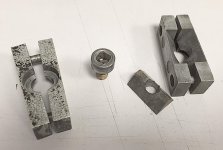Dave K2
Stainless
- Joined
- Apr 18, 2007
- Location
- Hertfordshire, England
I have been requested may times to make the part shown in my picture.

Its an expanding block used by letterpress printers.
When closed they are 50mm long by 17mm sq, the screw needs a square socket too to match existing tools.
Usually the blocks seem to be made from a hard grade of aluminium and the wedges from steel.
The two blocks are held loosely with crushed aluminium tube rivets so they can expand as the screw is tightened.
I just can't figure a way of making them in small batches in any way that is profitable - what sort of equipment would it take?
All I have is a CNC conversion of a Bridgeport mill which works very nicely but....
Any thoughts?

Its an expanding block used by letterpress printers.
When closed they are 50mm long by 17mm sq, the screw needs a square socket too to match existing tools.
Usually the blocks seem to be made from a hard grade of aluminium and the wedges from steel.
The two blocks are held loosely with crushed aluminium tube rivets so they can expand as the screw is tightened.
I just can't figure a way of making them in small batches in any way that is profitable - what sort of equipment would it take?
All I have is a CNC conversion of a Bridgeport mill which works very nicely but....
Any thoughts?




